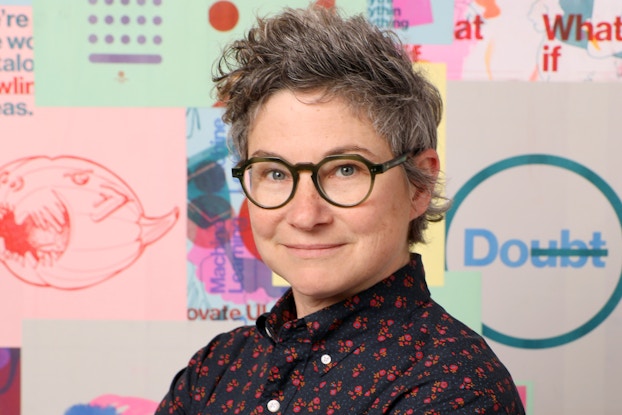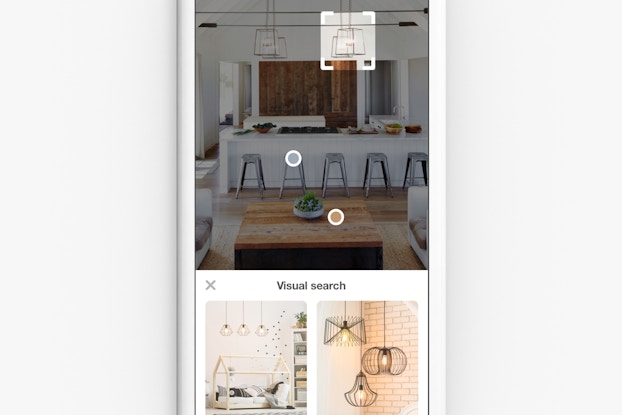
So you're a jazz buff with a penchant for Finnish design looking to create the foyer of your dreams. You're at a loss for words to describe it, but you know what it looks like in your mind’s eye. Pinterest is making it possible for you—and everyone else with a design fantasy—to seamlessly find a retailer and buy the entire look.
With its upgraded tech blend of proprietary algorithms and “human curation,” Pinterest is on a mission to shorten the distance between shopper inspiration and purchase as retailers wake up to the power of the visual web, hooking consumers in the early discovery stage of their online path to purchase.
It turns out the platform, which allows users to save images of products and ideas to virtual pinboards, is a highly successful purchasing funnel, Amy Vener, retail vertical strategy lead for Pinterest, told CO—. But it’s underutilized.
Now Pinterest is setting out to change that. “What we hope is that when a consumer discovers something on Pinterest, they seamlessly go to the company's site and can purchase there,” she said.
Tapping new tech to drive ‘old-school’ retail
Pinterest and retailers, in a choreographed muse-meets-commerce dance, are making it easier for customers to find and purchase what they are looking for based on images that intuit their idiosyncratic tastes and interests.
Once the social-scrapbooking site turns up the Finnish-rustic home décor the jazz-buff, for example, had in mind, it’s making it easier for her to buy the look, culling from millions of Product Pins that link directly to a retailer’s site.
The push comes as retailers and businesses of all sorts are leveraging insights from the platform to deliver more personalized and relevant shopping experiences for consumers who can get everything and anything they want online.
For its part, Pinterest is tapping advances in artificial intelligence and computer vision to take visual search to newly resonant heights, Vener said.
That experience comes to life on the platform for shoppers with features like Lens, a camera-search tool that identifies where objects in the real world can be bought online, just as its Taste Graph intuits billions of pinners’ ever-evolving interests, enabling the site to surface product recommendations, be it food, fashion or home décor, tailored to shoppers’ distinctive inclinations.
While that all sounds pretty high-tech, the idea behind it is actually more “old-school” retail, Vener said. The joy of discovery that comes from the treasure hunt appeal of shopping in store and mining unexpected finds is what Pinterest is going for, and what’s largely lacking from the often transactional and uninspiring experience of e-commerce, she said.
“Old-school retail is where you want to help someone get connected and inspired and emotionally charged” by showing them something they didn’t even know they wanted.
While voice activated shopping ala Google Home and Amazon’s Echo devices has garnered a lot of buzz, Vener is convinced that the (monetizable) future of helping retailers and brands reach consumers online is “through the visual experience,” just as they’ve done for ages in stores.
What we hope is that when a consumer discovers something on Pinterest, they seamlessly go to the company's site and can purchase there.Amy Vener, Retail Vertical Strategy Lead, Pinterest
‘Timeless driver of consumer behavior’
To that end, Pinterest is banking on the premise that the future of digital shopping, which is increasingly mobile, will be pictures, not words that get typed into a search bar. “The reality is that [merchants] want to get back to their roots to inspire something where they speak to shoppers emotionally,” she said.
The idea echoes a “timeless driver of consumer behavior,” Andrew Lipsman, principal analyst for eMarketer, told CO—. “People don’t buy products, they buy better versions of themselves. Pinterest created this perfect venue for aspiration and for people exploring their aspirations, and that is a very powerful thing.”
Pinterest’s retail strategy follows earlier iterations of social commerce, which mostly flopped (rest in peace, Facebook Commerce and Twitter buy buttons). Lipsman says that's because people mostly visit those platforms to interact with other people, as opposed to purchase things.
“But what happened after social commerce busted is that Pinterest and Instagram, the leaders of the visual web that organically lend themselves to image-driven shopping behaviors, have sparked the reemergence of social commerce in recent years.”
Indeed, Pinterest users are in open-to-buy-mode, Vener said. The very nature of activity on the site — pinning products and ideas from home décor and hair and beauty to weddings and travel — and creating inspiration boards around them, inspires users to shop, even when they’re not actively looking for something specific, and consumers expect brands to be there, she said.
According to eMarketer data, 7%, 10% and 14% of Twitter, Facebook and Instagram users, respectively, tap those sites to find and shop for products, compared to 48% of pinners, “which shows very clearly how strongly users look to Pinterest as a shopping platform,” Lipsman said.

Monetizing the shopper-discovery phase
Still, when it comes to online shopping, marketers have long prized the “last click” right before checkout as the key performance metric.
The measurement has undervalued the sales-driving potential of platforms like Pinterest that influence shoppers’ decisions early in the buying process. Instead, “Retailers need to think of that [entire] path to purchase and not just that last signal of intent,” Vener said.
Now multitouch attribution methods have revealed that shepherding pinners from the seed of inspiration in “life’s planning moments” — be it mulling a cocktail party look or a holiday meal — to the checkout screen is starting to pay off for brands, she said.
Pinterest tracked that pinners spend 29% more at retail than non-pinners, while nine out of 10 Pinterest devotees are moved to purchase because of what they discovered on the site. As merchants increasingly tap Pinterest as a bona fide purchasing pipeline, “We’re finding a lot of success with retailers,” Vener said.
The ‘Taste Graph’: Pinterest’s secret sauce
While purpose-driven shopping is concrete—knowing you need that jug of Tide detergent or want those Nike Air Max kicks—the visual-discovery mindset of pinners is often wordless.
Shoppers don’t necessarily know what they want until they spot it, and aesthetic preferences are difficult to articulate, Vener said. Pinterest sees the intersection of human curation and proprietary algorithms as its secret sauce in guiding them to it.
The platform’s visual discovery engine identifies what’s in an image, ideas related to it, what a person is interested in, and even what they’ll want next. It can show consumers ideas based on visual similarities and the overlapping interests of more than 250 million people, particularly in the highly shoppable areas of food, home, style and beauty.
The platform is now looking to its Taste Graph to convert more pinners into shoppers by personalizing the shopping experience. The technology connects Pinterest’s 250 million users to more than 175 billion ideas by modeling “how the world’s tastes and interests evolve over time,” according to the company.
It’s how Pinterest analyzes the myriad interests of the John Coltrane/Swedish design buff to surface the stone tiles and Marimekko throw pillows of her foyer-envisioning dreams.
“We’re taking a pin and looking at all human signals of intent that are associated with that pin, which is a really rich set of [consumer] data” that goes beyond standard demographic cues like age, income and zip code, Vener said.

Bridging the distance between search and sale
But it’s not enough to stoke inspiration. Shoppers need an easy way to act on those ideas and make a purchase, which is where visual search tools like Lens come in, as well Product Pins.
Pinterest has made hundreds of millions of pins shoppable with up-to-date pricing and stock information, and links that click directly to the checkout page on a retailer’s site where a person can buy in a few clicks. These pins are identified by a new shopping tag icon, which also indicate if a product is in stock.
Meanwhile the Lens feature, which lives in Pinterest’s mobile app, detects objects in the real world and suggests related items available for purchase. So, just as a consumer who zaps the Shazam music discovery app at a speaker confirms that it’s Brandi Carlile’s “The Joke” playing in their local Starbucks, with Lens, she can also snap a photo of the brass chandelier hanging above the barista and find objects like it to buy.
Pinterest says the visual search technology that powers Lens is smarter than it’s ever been, understanding five times as many things than it did just a year ago, from thousands of clothing styles to objects one might find in a home.
Lens is now integrated into Target's registry app, for one: shoppers snap a picture of what inspires them in the real world, and are then served up a curated set of related Target.com products.
Lens reflects what Lucie Greene, worldwide director of the Innovation Group for J. Walter Thompson, dubs “transcendent retail,” and “the Internet of eyes,” as digital shopping morphs into a more immersive experience that dissolves silos between offline and online spaces to offer shoppers something more. These include a L’Oréal wearable sensor that measures skin pH levels and suggests customized products to a Google app that calls up the nutritional value of that box of corn flakes in the cereal aisle.
Like Lens, these tools “create opportunities for brands to deliver more specific product recommendations to shoppers,” which they increasingly expect, Greene said.
Branding the unbranded
Beyond big, high-profile established retailers and brands like Target, visual search on Pinterest is coaxing the growth of up-and-coming retailers and direct-to-consumer upstarts like Purple mattress, which has seen its customer acquisition costs drop 34% from exposure on Pinterest, according to its testimonial on the site.
Pinterest’s very model is helping to nudge the rise of nascent brands because 97% of consumers’ searches on Pinterest are unbranded. So visual search on the site can be a boon for small and midsized businesses looking to reach new shoppers and build incremental growth, Vener said.
But while Pinterest is bullish on its own growth as a shopping funnel, the site still remains a tiny fraction of total search volume, generating about 1 billion monthly searches, compared with hundreds of billions of text searches, eMarketer’s Lipsman noted. “It lacks the scale of the biggest platforms,” he said. “What they’re up against is that most advertisers are dumping the biggest portions of their digital budgets into Facebook and Google, as they reach the most people.”
Vener sees that mindset changing. “Brands are looking for new opportunities to find customers,” she said. And on Pinterest, "They’re finding customers they haven’t reached before.”
CO— aims to bring you inspiration from leading respected experts. However, before making any business decision, you should consult a professional who can advise you based on your individual situation.
CO—is committed to helping you start, run and grow your small business. Learn more about the benefits of small business membership in the U.S. Chamber of Commerce, here.






